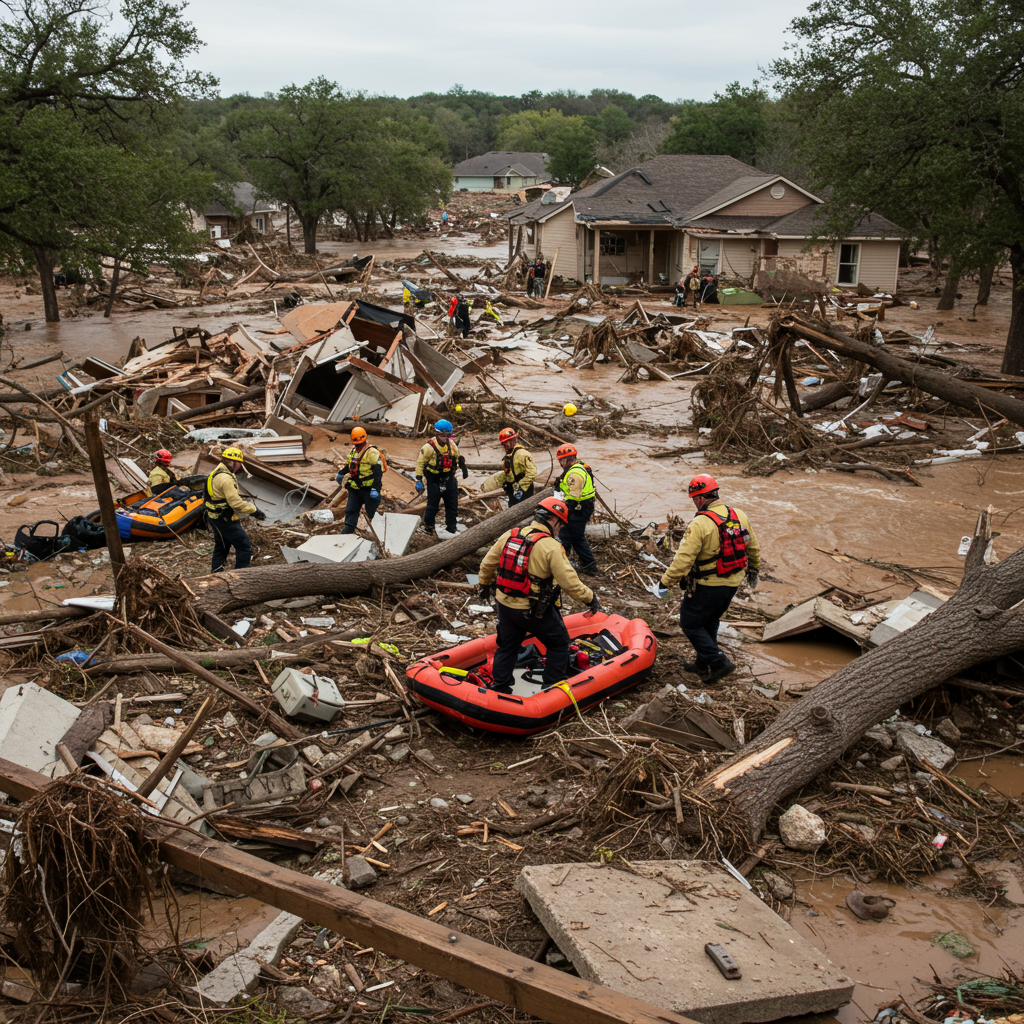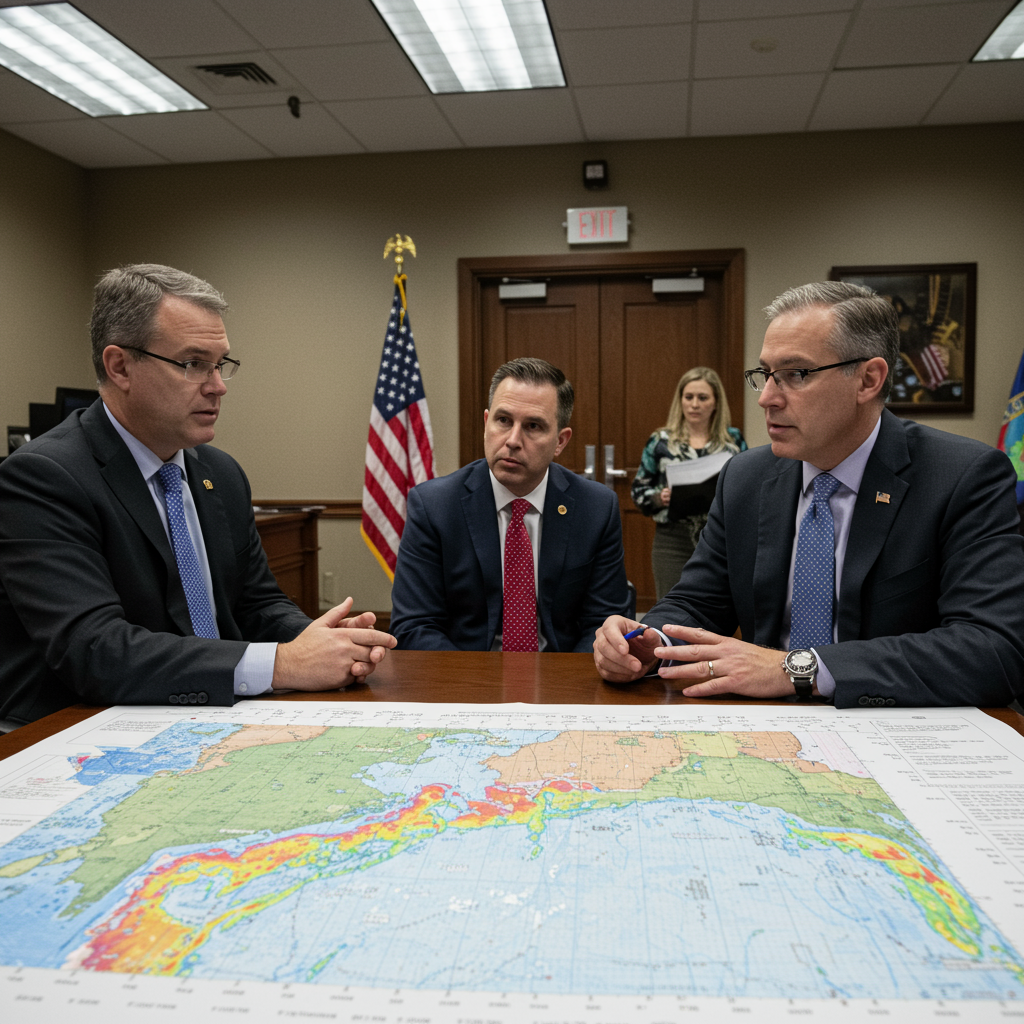A catastrophic flash flood tore through the heart of the Texas Hill Country before dawn on Saturday, July 5, 2025, unleashing a wall of water down the Guadalupe River and transforming a serene landscape into a scene of devastation. The sudden deluge left scores dead and dozens missing, triggering a desperate search across mangled debris and overwhelmed camps. Authorities confirmed at least 51 fatalities by Saturday evening, including numerous children, with rescuers racing against time to locate survivors, including a specific group of 27 young girls from a beloved summer camp still unaccounted for. The scale of the destruction, particularly impacting areas popular during the July Fourth weekend, presented immense challenges for search and recovery operations.
A River’s Deadly Fury
The disaster unfolded with terrifying speed late Friday night and into Saturday morning. Fueled by a massive storm that dumped nearly a foot of rain in a short period, the Guadalupe River, a centerpiece of recreation in the hilly region, experienced an unprecedented surge. Reports indicate the river rose a staggering 26 feet in just 45 minutes near Hunt, Texas, unleashing its destructive power. This rapid rise sent a torrent of water sweeping through riverfront communities, century-old youth camps, and private properties. The sheer force of the floodwaters was immense, washing away homes, overturning vehicles, and leaving behind a chaotic expanse of muck and debris. The area, known locally as “flash flood alley” due to its rocky terrain that prevents rain from soaking into the ground, making it highly susceptible to rapid runoff, proved tragically vulnerable to this intense cloudburst.
The Search for Survivors Intensifies
As daylight broke on Saturday, the grim reality of the flood’s impact became clear. Rescue teams immediately launched extensive operations across the devastated area. Using helicopters, boats, and drones, searchers scoured the flood-ravaged landscape. Their mission involved navigating treacherous conditions, sifting through debris piles along the riverbanks, and reaching isolated pockets where people might be stranded. Rescuers successfully pulled numerous individuals from dangerous situations, including people clinging to trees or cut off by washed-out roads. Officials reported that more than 850 people had been rescued in the 36 hours following the onset of the flooding, a testament to the tireless efforts of first responders and volunteers. Governor Greg Abbott pledged that search operations would continue “around the clock,” with teams expanding their efforts into newly accessible areas as floodwaters began to recede slightly in some places.
Heavy Toll: Lives Lost and Those Still Missing
The human cost of the flash flood is heartbreakingly high. As of Saturday evening, authorities confirmed a death toll of at least 51 people. This figure includes at least 43 fatalities within Kerr County alone and an additional eight deaths reported in nearby counties. Among the deceased were a significant number of children. While initial reports placed the number at 15 children among the Kerr County victims, later counts detailed 14 children among 32 total deaths specifically confirmed in that region. The full number of missing individuals beyond those recovered remained difficult to ascertain immediately. However, a major focus of the ongoing search was the fate of 27 missing girls from Camp Mystic, a prominent Christian summer camp located directly in the path of the flood’s fury. Most of the Kerr County fatalities were tragically recovered from the area surrounding this camp, which was described by a camper as “completely destroyed.”
Harrowing Accounts of Survival
Survivors recounted terrifying experiences as the floodwaters struck with little warning. Elinor Lester, a 13-year-old camper at Camp Mystic, described being woken just after midnight by the raging storm. She recounted being evacuated by helicopter and then guided by rope across a bridge as water whipped dangerously around her legs, highlighting the sudden chaos and fear. Residents also shared harrowing tales of survival. Erin Burgess from Ingram described water pouring into her home just 20 minutes after she woke to thunder. She and her teenage son clung to a tree for an agonizing hour after being swept from their home. Another resident, Barry Adelman, recalled his family, including his 94-year-old grandmother and 9-year-old grandson, being forced into their attic as water rose inside their three-story house, fearing for their lives while trying to comfort the child. These stories underscore the speed and intensity of the flood that caught many unaware.
Questions Arise Over Warnings and Preparedness
The rapid and deadly nature of the flood prompted questions about whether adequate warnings were issued to residents and the many camps in the flood-prone area. While local officials, including Kerr County Judge Rob Kelly and U.S. Rep. Chip Roy, characterized the event as an unexpected “once-in-a-century flood,” highlighting the unprecedented intensity of the rainfall, others suggested more could have been done. Private forecasting company AccuWeather, along with the National Weather Service, stated they had issued warnings about the potential for flash flooding hours before the devastation occurred, arguing these should have provided sufficient time for evacuations. The Hill Country is known for its susceptibility to sudden floods due to its terrain and numerous water crossings. Judge Kelly acknowledged that a proposal for a river flood warning system had been considered years prior but was not implemented due to cost concerns. In contrast, officials at some other nearby camps, like Mo-Ranch Camp and Camps Rio Vista and Sierra Vista, reported monitoring weather forecasts and proactively moving campers to higher ground, successfully mitigating the impact on their sites.
Transition to Recovery and Support Efforts
As the immediate rescue efforts continued through Saturday, authorities recognized the operation was gradually transitioning towards a long and challenging recovery phase. The landscape along the Guadalupe River remained a scene of destruction, requiring extensive work to locate remaining victims and begin the process of clearing debris and assessing damage. The devastating event brought back somber memories of past floods in the region, including a 1987 incident where 10 campers died near Comfort, further north. State and federal support quickly mobilized, with Governor Abbott declaring Sunday a day of prayer for the state and Homeland Security Secretary Kristi Noem pledging federal resources, including Coast Guard assistance. Reunification centers were set up at local schools, though many families were still desperately seeking information about missing loved ones. Austin Dickson, CEO of the Community Foundation of the Texas Hill Country, noted the area’s unique hydrology where water rushes off hills rather than soaking in, contributing to the rapid rise of rivers and emphasizing the need for long-term recovery support.
Frequently Asked Questions
What caused the historic flash flood in the Texas Hill Country?
The devastating flash flood was caused by an intense storm that dropped nearly a foot of rain in a short period on Friday night and Saturday morning. The rocky terrain of the Texas Hill Country prevents water from soaking into the ground effectively, leading to rapid runoff into rivers like the Guadalupe. The river itself rose an alarming 26 feet in just 45 minutes, overwhelming its banks and causing catastrophic flooding.
How many people were killed and are still missing from the Texas floods?
As of Saturday, July 5, 2025, at least 51 people were confirmed dead due to the flooding across central Texas. This total includes at least 43 fatalities in Kerr County, with 15 children confirmed among the victims there. An additional eight deaths occurred in nearby counties. While many have been accounted for, at least 27 girls from Camp Mystic remain missing, and authorities have not yet provided a total count for other potentially missing individuals due to the scale and timing (holiday weekend) of the disaster.
What kind of rescue efforts are underway and what is the status?
Massive search and rescue operations were launched immediately after the floodwaters hit. Teams are using a combination of helicopters, boats, and drones to search flooded riverbanks, survey devastated areas, and locate victims or stranded survivors. Over 850 people were rescued in the first 36 hours. The search is ongoing “around the clock” and expanding into new areas as waters recede, but officials acknowledge the operation is transitioning towards a difficult recovery phase focused on locating remaining missing persons amidst extensive debris.
A Community Faces a Long Recovery
The catastrophic flash flood in the Texas Hill Country on July 5, 2025, delivered a severe blow, leaving a trail of death, destruction, and unanswered questions about the missing. As rescuers continue their exhaustive search efforts, the focus is beginning to shift towards the daunting task of recovery. The devastation to homes, businesses, and natural areas is immense, and the emotional toll on families who have lost loved ones or are still awaiting news is immeasurable. Governor Abbott’s call for a day of prayer underscores the deep impact on the community. The event serves as a stark reminder of the power of nature and the specific vulnerabilities of regions like the Hill Country. While the immediate crisis response has been significant, the path to rebuilding lives and communities along the Guadalupe River will be long and challenging, requiring sustained support and resilience.




